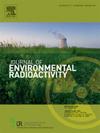Characterization of rock fractures for fractal modeling of radon gas transport
IF 1.9
3区 环境科学与生态学
Q3 ENVIRONMENTAL SCIENCES
引用次数: 0
Abstract
Enhancing the predictability of radon flux in fractured environments, particularly in confined spaces, is a crucial step towards mitigating the profound health risks associated with radon gas exposure. However, previous models on fluid transport through fractured rock have focused on the relationship between radon flux and aperture in fractures and faults. However, there is paucity of understanding on the influence of rock geo-mechanical properties on radon flux. In addition, there are limited methods of characterizing rocks in relation to radon flux. The numerical model presented in this study incorporated rock properties such as Young's modulus and Poisson ratio with rock aperture to develop a dimensionless radon flux for opening-mode fractures, and five dimensionless parameters (e.g., Geofluid number, Decay number, Fracgen number, Geofrac number, and Geopeclet number) were introduced to characterize fractures in terms of radon transport. Furthermore, these newly discovered relationships were used to conduct a series of flow simulations on fracture networks using the discrete fracture network model (DFN). This model establishes a quantitative framework for predicting radon flux through open-mode fractures and the influence of rock geo-mechanical properties.
为氡气迁移的分形建模确定岩石裂缝的特征
提高断裂环境(尤其是密闭空间)中氡通量的可预测性,是减轻氡气暴露对健康造成的巨大危害的关键一步。然而,以往有关流体在断裂岩石中迁移的模型主要关注氡通量与断裂和断层孔径之间的关系。然而,人们对岩石地质力学特性对氡通量的影响了解甚少。此外,描述岩石与氡通量关系的方法也很有限。本研究提出的数值模型将岩石特性(如杨氏模量和泊松比)与岩石孔隙度结合起来,为开口模式裂缝建立了一个无量纲氡通量,并引入了五个无量纲参数(如地质流体数、衰减数、Fracgen 数、Geofrac 数和 Geopeclet 数),从氡迁移的角度描述裂缝的特征。此外,还利用这些新发现的关系,使用离散断裂网络模型(DFN)对断裂网络进行了一系列流动模拟。该模型建立了一个定量框架,用于预测通过开放模式裂缝的氡通量以及岩石地质力学特性的影响。
本文章由计算机程序翻译,如有差异,请以英文原文为准。
求助全文
约1分钟内获得全文
求助全文
来源期刊

Journal of environmental radioactivity
环境科学-环境科学
CiteScore
4.70
自引率
13.00%
发文量
209
审稿时长
73 days
期刊介绍:
The Journal of Environmental Radioactivity provides a coherent international forum for publication of original research or review papers on any aspect of the occurrence of radioactivity in natural systems.
Relevant subject areas range from applications of environmental radionuclides as mechanistic or timescale tracers of natural processes to assessments of the radioecological or radiological effects of ambient radioactivity. Papers deal with naturally occurring nuclides or with those created and released by man through nuclear weapons manufacture and testing, energy production, fuel-cycle technology, etc. Reports on radioactivity in the oceans, sediments, rivers, lakes, groundwaters, soils, atmosphere and all divisions of the biosphere are welcomed, but these should not simply be of a monitoring nature unless the data are particularly innovative.
 求助内容:
求助内容: 应助结果提醒方式:
应助结果提醒方式:


